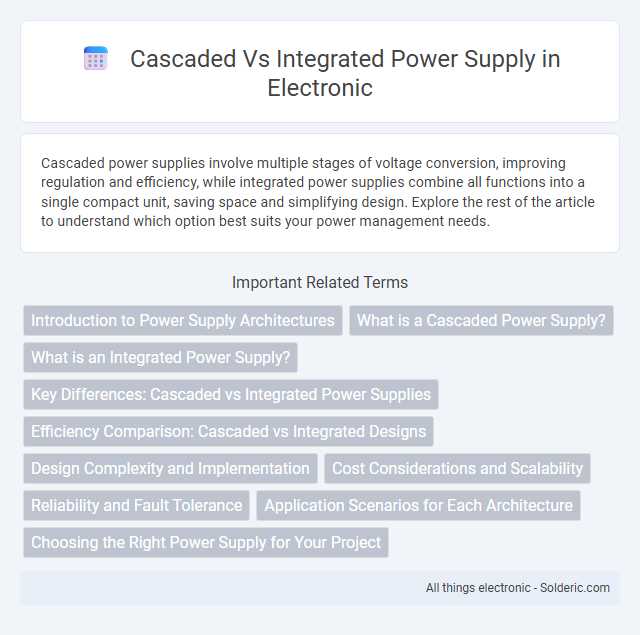Cascaded power supplies involve multiple stages of voltage conversion, improving regulation and efficiency, while integrated power supplies combine all functions into a single compact unit, saving space and simplifying design. Explore the rest of the article to understand which option best suits your power management needs.
Comparison Table
| Feature | Cascaded Power Supply | Integrated Power Supply |
|---|---|---|
| Design | Multiple separate power modules connected in series/parallel | Single unit with combined functions and components |
| Efficiency | Lower due to inter-module losses | Higher with optimized internal design |
| Size | Larger footprint from multiple units | Compact, space-saving design |
| Reliability | Moderate; failure in one module affects output | Higher reliability with integrated protections |
| Cost | Typically lower initial cost but higher assembly cost | Higher upfront cost, lower lifecycle cost |
| Maintenance | Modular replacements simplify repairs | Requires specialized servicing |
| Application | Flexible for custom voltage/current levels | Standardized for specific power needs |
| Thermal Management | Requires external cooling solutions | Built-in thermal controls improve heat dissipation |
Introduction to Power Supply Architectures
Cascaded power supply architectures connect multiple power stages in series or parallel, enabling voltage scaling and improved efficiency for high-power applications. Integrated power supplies combine key components, such as controllers and converters, into a single module, reducing size and enhancing thermal management. Selecting between cascaded and integrated designs depends on system requirements for scalability, efficiency, and compactness.
What is a Cascaded Power Supply?
A cascaded power supply consists of multiple power supply units connected in series or sequence to achieve higher voltage or enhanced control over power delivery. This configuration allows for modular scalability and improved fault tolerance compared to integrated power supplies, which combine all components into a single unit. Understanding the benefits of a cascaded power supply can help optimize Your system's voltage requirements and reliability.
What is an Integrated Power Supply?
An integrated power supply combines multiple power conversion stages within a single unit, enhancing efficiency and reducing overall footprint compared to cascaded power supplies. It streamlines power management by embedding controllers, regulators, and protection circuits on one compact platform, improving reliability and reducing electromagnetic interference. This design enables better thermal management and simplifies installation in applications like industrial automation and telecommunications.
Key Differences: Cascaded vs Integrated Power Supplies
Cascaded power supplies consist of multiple independent modules connected sequentially, allowing greater flexibility in voltage and current customization, while integrated power supplies combine components into a single compact unit for enhanced efficiency and reduced footprint. You can expect cascaded designs to offer easier maintenance and scalability, whereas integrated supplies typically deliver improved thermal management and lower electromagnetic interference. Key differences lie in modularity, space requirements, and performance optimization, influencing your choice based on application complexity and design constraints.
Efficiency Comparison: Cascaded vs Integrated Designs
Integrated power supply designs generally offer higher efficiency due to reduced power loss from fewer conversion stages and minimized interconnects. Cascaded power supplies involve multiple stages that can introduce cumulative losses, resulting in lower overall efficiency compared to integrated systems. The streamlined architecture of integrated designs optimizes energy transfer, enhancing performance in applications demanding maximum power efficiency.
Design Complexity and Implementation
Cascaded power supply designs exhibit higher design complexity due to multiple discrete stages requiring precise coordination and isolation, often increasing implementation challenges and spatial requirements. Integrated power supplies streamline the design by combining components into a single unit, reducing PCB size and simplifying thermal management, which accelerates development time and improves reliability. This integration, however, demands advanced semiconductor processes and careful layout to maintain efficiency and minimize electromagnetic interference.
Cost Considerations and Scalability
Cascaded power supplies typically have lower initial costs due to modular, off-the-shelf components but may incur higher installation and maintenance expenses as system complexity increases. Integrated power supplies offer higher upfront investment with streamlined assembly, resulting in reduced long-term operational costs and improved reliability. Scalability favors cascaded designs for easy expansion by adding modules, while integrated systems require redesign or replacement to scale, impacting flexibility and total cost of ownership.
Reliability and Fault Tolerance
Cascaded power supplies offer higher fault tolerance by isolating failures within individual modules, preventing total system shutdown and allowing selective maintenance. Integrated power supplies, while more compact and cost-effective, typically present lower reliability since a fault affects the entire system, requiring full replacement or repair. For mission-critical applications, cascaded configurations enhance system uptime and support redundancy, whereas integrated designs favor simplicity over fault isolation.
Application Scenarios for Each Architecture
Cascaded power supplies are ideal for applications requiring multiple voltage levels or heightened isolation between stages, such as industrial automation systems and complex testing equipment. Integrated power supplies excel in compact devices demanding high efficiency and space-saving designs, including smartphones, laptops, and embedded systems. Your choice depends on the system's complexity, size constraints, and voltage requirements, ensuring optimal performance and reliability.
Choosing the Right Power Supply for Your Project
Selecting the right power supply for your project depends on factors like efficiency, size, and complexity. Cascaded power supplies allow for modular voltage levels and easier troubleshooting, while integrated power supplies offer compact design and simplified wiring, ideal for space-constrained applications. Understanding your project's power requirements and environmental constraints will help you decide between the flexibility of cascaded systems and the streamlined performance of integrated solutions.
cascaded vs integrated power supply Infographic

 solderic.com
solderic.com